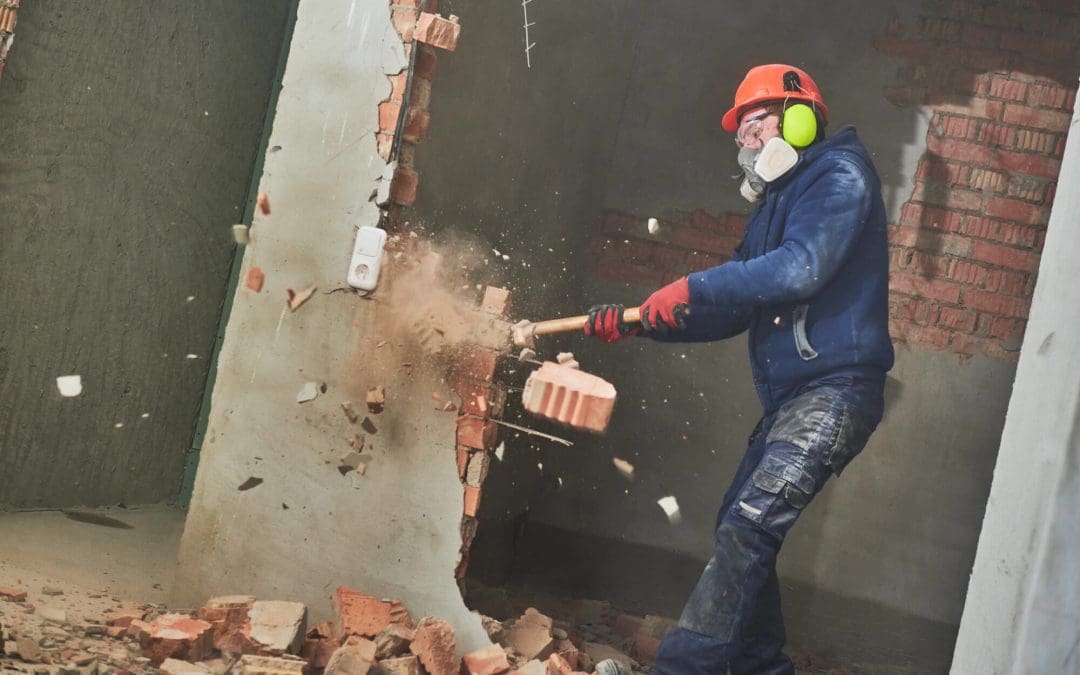DIY demolition can be one of the most satisfying parts of a home renovation project. There’s something about tearing out old cabinets or busting up tile that feels productive. It’s loud, messy, and oddly therapeutic. But there’s a big difference between smart demolition and blindly swinging a sledgehammer into a wall. If you’re thinking about DIY demolition work, it’s worth taking the time to do it right. Here’s what you need to know before getting started.
Plan First, Smash Later
The biggest mistake people make with DIY demolition is getting too excited and jumping in without a plan. Don’t start ripping things out just because you’re eager to see progress. Figure out exactly what needs to come out, what’s staying, and what might be reused or donated. If you’re remodeling a kitchen, for example, know which walls are coming down, what utilities might be hidden inside them, and where your shutoff valves are.
Also, check to see if any of the materials might contain lead paint or asbestos. You don’t want to disturb these without proper precautions. If your home was built before 1980, it’s worth having suspect materials tested by a pro.
Understand What’s Behind the Wall Before Starting DIY Demolition Work
Before you take out any wall, you need to know what’s inside it. Electrical wiring, plumbing lines, HVAC ducts, or even load-bearing supports could be running through that space. Cutting into the wrong spot could lead to expensive repairs—or worse, injury.
Stud finders and circuit tracers can help you locate wiring and studs. Shut off power at the breaker panel before touching any outlets or switches. If you’re not sure what’s inside the wall, remove a small section first to take a look. Don’t assume. Check.
Load-bearing walls are another concern. Removing one without proper support can cause serious structural damage. If you’re dealing with anything more than a simple non-load-bearing wall, it’s worth bringing in a structural engineer or contractor to take a look before you proceed.
Safety Isn’t Optional in DIY Demolition Work
Demolition can be dangerous. Sharp nails, broken tile, exposed wires, and heavy debris are all part of the job. Don’t skip the safety gear. At a minimum, you need safety glasses, heavy gloves, a dust mask or respirator, and sturdy boots. If you’re tearing out drywall or plaster, a long-sleeve shirt and pants will help protect your skin.
Make sure the area is clear of kids, pets, and unnecessary furniture. Cover any nearby items you don’t want covered in dust, and keep a fire extinguisher nearby if you’re working around electrical.
Also, be smart about your posture and lifting technique. That old tub might not look too heavy until you throw your back out trying to move it by yourself.
Tools That Make the Job Easier
You don’t need a truckload of tools to handle basic demolition, but a few key items make a big difference. A good quality pry bar is your best friend for pulling apart framing and removing trim without damaging nearby surfaces. A sledgehammer can be useful for breaking up tile or concrete, but don’t use it for everything—controlled demo is better than brute force.
A reciprocating saw helps cut through nails, drywall, and wood studs. If you’re dealing with tile or flooring, a hammer, chisel, or oscillating tool will be useful. For cleanup, invest in a heavy-duty contractor bag and maybe a shop vac for the finer debris.
Know When to Call in Help
DIY demolition doesn’t mean you have to do everything yourself. Some tasks are better left to the pros. If you find mold, asbestos, or structural damage, stop and get a second opinion. Same goes for anything involving gas lines or major electrical work.
Calling in help early might actually save you money in the long run. It can prevent mistakes that lead to costly fixes later.
Cleanup Is Half the Job
Once the wall is down or the cabinets are out, you’ve still got work to do. Hauling out the debris and cleaning the site is a big part of the process. Most home renovation debris can’t just go in your regular trash. Look into renting a small dumpster or taking materials to a construction waste drop-off site.
Sweep and vacuum the area thoroughly. If you’ve opened up walls or ceilings, expect a lot of dust. The cleaner the space, the easier it’ll be to start your actual renovation work.
FAQs on DIY Demolition Work
Is DIY demolition safe for beginners?
Yes, as long as you do your research, wear proper safety gear, and avoid anything involving structural elements or hazardous materials. Know your limits and don’t rush the job.
How do I know if a wall is load-bearing?
You can look for clues like joists resting on the wall or it being located in the center of the house, but the safest option is to consult a professional if there’s any doubt.
What’s the easiest demolition project for a first-timer?
Removing carpet, baseboards, or non-load-bearing drywall is a good place to start. These jobs are simple, low-risk, and help you get comfortable with the process.
Can I reuse or donate old materials?
Absolutely. Old cabinets, doors, and fixtures can often be reused or donated to local salvage centers or charities. It’s a great way to cut down on waste and help someone else out.
Do I need a permit for demolition?
It depends on where you live and what you’re tearing out. Removing walls or anything structural usually requires a permit. To be safe, check with your local building department.
All Pro Property Inspections offers home inspections in San Diego and the surrounding area. Contact us to schedule an appointment.

